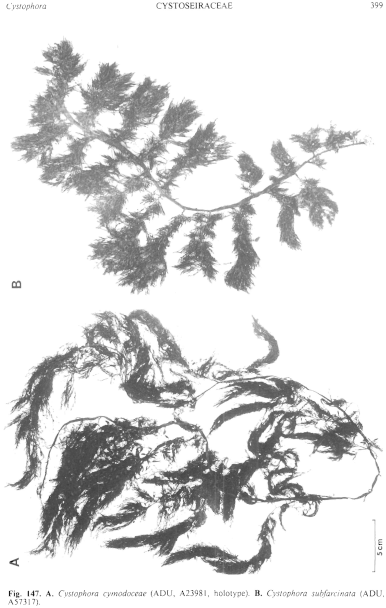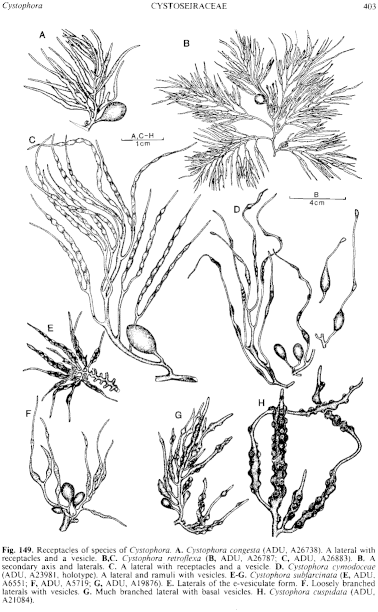|
|
|
|
|
|||||||||||
|
Electronic Flora of South Australia Species Fact Sheet
Phylum Phaeophyta – Order Fucales – Family Cystoseiraceae
Selected citations: Nizamuddin 1964c: 42–63. Womersley 1964: 95, figs 38–40, pl. 13.
Synonym
Fucus subfarcinatus Mertens 1819: 184.
Thallus (Fig. 147B) medium to dark brown, young plants often light brown, 20–80 cm (-2 m) long, with primary and often long secondary axes bearing dense, lateral, tufts of ramuli. Holdfast discoid-conical, 3–12 mm across, with a single, short, subterete stipe; epilithic. Primary axes compressed, 2–7 mm broad and 1–2 (–3) mm thick, with narrow edges, slightly flexuous, distichously branched from the face with dense, usually short, secondary axes (1–) 2–8 cm long; secondary (and tertiary) axes slightly retroflex, densely and distichously branched, often basally denuded with short, close-set residues. Laterals (Fig. I 49E–G) simple to (usually) irregularly alternately branched, not in one plane; ramuli terete, simple or branched, (0.5–) 1–3 cm long and 0.4–0.7 mm in diameter. Vesicles absent (in rough-water forms) or present (Fig. 149F,G) and usually abundant, replacing the basal ramulus of a lateral, petiolate, elongate-ovoid to subspherical, mutic, 2–4 (–6) mm long, 2–3 (–4) mm in diameter.
Reproduction: Thalli monoecious. Receptacles (Fig. 149E–G) simple or often branched, (0.5–) 1–3 (–5) cm long, 1–2 mm thick at conceptacles, with prominent, swollen, irregularly placed conceptacles, often a few near the base more or less in two rows, usually with sterile tissue between the conceptacles and a prominent sterile awn. Conceptacles bisexual or occasionally unisexual, with ostioles scattered or in two rows near the base, with simple paraphyses; oogonia sessile, ovoid, 80–120 µm long and 50–70 µm in diameter; antheridia sessile or on branched paraphyses, ovoid, 25–35 µm long and 14–16 µm in diameter.
Selected specimens: Nickol Bay, W. Aust. (1880; Herb. Sonder, MEL, 397/398). Middleton Beach, Albany, W. Aust., drift (Levring, 3.vii.1948; ADU, A56091). Belinda Beach, Middle I., Recherche Arch., W. Aust., uppermost sublittoral (Trudgen 834, 23.xi.1973; ADU, A51688 and PERTH). Pearson I., S. Aust., upper sublittoral (Edmonds, 16.ii.1960; ADU, A24481). Venus Bay, S. Aust., sublittoral fringe ( Womersley, 12.ii.1954; ADU, A19507). Snapper Point, Port Lincoln, S. Aust., 2–3 m deep (Baldock, 1.i.1964; ADU, A27098). Aldinga, S. Aust., upper sublittoral pools (Shepley, 4.iv.1954; ADU, A20249). American R. inlet, Kangaroo I., S. Aust., drift (Womersley, 2.vi.1947; ADU, A5719). Pennington Bay, Kangaroo I., S. Aust., low eulittoral ( Womersley, 4.i.1948; ADU, A6551). Robe, S. Aust., upper sublittoral pools (Womersley, 15.iii.1955; ADU, A19876 and 16.xii.1986; ADU, A57317-"Marine Algae of southern Australia" No. 277). Cape Otway, Vic., upper sublittoral pools ( Womersley, 14.v.1982; ADU, A55536). Sorrento, Vic., upper sublittoral pools, ocean beach ( Womersley, 2.vi.1953; ADU, A18816). Walkerville, Vic., upper sublittoral pools (Sinkora A2128, 2.iii.1975; ADU, A48539). Rocky Cape, N.W. Tas., lower eulittoral pools (Womersley, 17.x.1982; ADU, A55551). Coles Bay, Tas., upper sublittoral pools ( Womersley, 4.xi.1982; ADU, A56222). Louisville, Prosser Bay, Tas., upper sublittoral (Olsen, 9.iii.1964; ADU, A27461).
Distribution: From Nickol Bay, W. Aust. to Wilsons Prom., Vic. and around Tasmania.
Taxonomic notes: Type from Tasmania; fragments in LD.
C. subfarcinata is probably the commonest species of Cystophora on southern Australian coasts, in shallow water (to about 5 m deep) under conditions of strong to moderate wave action; vesicles are not formed on plants on rough-water coasts. It is characterised by the habit, the short, tufted, secondary or tertiary axes and laterals, and the swollen conceptacles scattered irregularly along the receptacles which typically have a sterile terminal awn.
References:
AGARDH, J.G. (1848). Species, Genera et Ordines Algarum. Vol. 1. (Gleerup: Lund.)
AGARDH, J.G. (1896). Analecta Algologica. Cont. III. Ada Univ. lund. 32, 1–140, Plate 1.
MERTENS, M. (1819). Sur plusieurs espêces de Fucus, nouvelles ou peu connues, observées dans la collection du Muséum. Mem. Mus. Natl Hist. Nat., Paris 5, 172–90, Plates 13–15.
NIZAMUDDIN, M. (1964c). The anatomy and life history of Cystophora, Acrocarpia and Caulocystis (Fucales). Bot. Mar. 7, 42–63.
WOMERSLEY, H.B.S. (1964). The morphology and taxonomy of Cystophora and related genera (Phaeophyta). Aust. J. Bot. 12, 53–110, Plates 1–16.
The Marine Benthic Flora of Southern Australia Part II complete list of references.
Publication:
Womersley, H.B.S. (14 December, 1987)
The Marine Benthic Flora of Southern Australia
Part II
©Board of the Botanic Gardens and State Herbarium, Government of South Australia
Illustrations in Womersley Part II, 1997: FIGS 147B, 149 E–G.

Figure 147 enlarge
Fig. 147. A. Cystophora cymodoceae (ADU, A23981, holotype). B. Cystophora subfarcinata (ADU, A57317).

Figure 149 enlarge
Fig. 149. Receptacles of species of Cystophora. A. Cystophora congesta (ADU, A26738). A lateral with receptacles and a vesicle. B,C. Cystophora retroflexa (B, ADU, A26787; C, ADU, A26883). B. A secondary axis and laterals. C. A lateral with receptacles and a vesicle. D. Cystophora cvmodoceae (ADU, A2398l, holotype). A lateral and ramuli with vesicles. E–G. Cystophora subfarcinata (E, ADU, A6551; F, ADU, A5719; G, ADU, A19876). E. Laterals of the e-vesiculate form. F. Loosely branched laterals with vesicles. G. Much branched lateral with basal vesicles. H. Cystophora cuspidata (ADU, A21084).

|
Email Contact: State Herbarium of South Australia |

|